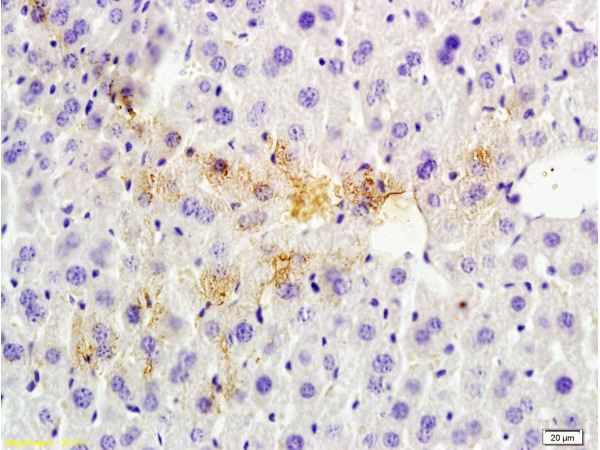TSG101 antibody [4A10]
GTX70255
ApplicationsElectron Microscopy, Flow Cytometry, ImmunoFluorescence, ImmunoPrecipitation, Western Blot, ELISA, ImmunoCytoChemistry, ImmunoHistoChemistry, ImmunoHistoChemistry Paraffin
Product group Antibodies
ReactivityCanine, Hamster, Human, Monkey, Mouse, Porcine, Rat, Zebra Fish
TargetTSG101
Overview
- SupplierGeneTex
- Product NameTSG101 antibody [4A10]
- Delivery Days Customer9
- Application Supplier NoteWB: 1:500-1:3000. ICC/IF: 1:500-1:1000. IHC-P: 1:100-1:1000. FACS: 1:25-1:200. EM: . IHC: 1:100. *Optimal dilutions/concentrations should be determined by the researcher.Not tested in other applications.
- ApplicationsElectron Microscopy, Flow Cytometry, ImmunoFluorescence, ImmunoPrecipitation, Western Blot, ELISA, ImmunoCytoChemistry, ImmunoHistoChemistry, ImmunoHistoChemistry Paraffin
- CertificationResearch Use Only
- ClonalityMonoclonal
- Clone ID4A10
- Concentration1.8 mg/ml
- ConjugateUnconjugated
- Gene ID7251
- Target nameTSG101
- Target descriptiontumor susceptibility 101
- Target synonymsTSG10, VPS23, tumor susceptibility gene 101 protein, ESCRT-I complex subunit TSG101, tumor susceptibility gene 10, tumor susceptibility gene 101, tumor susceptibility protein
- HostMouse
- IsotypeIgG1
- Protein IDQ99816
- Protein NameTumor susceptibility gene 101 protein
- Scientific DescriptionThe protein encoded by this gene belongs to a group of apparently inactive homologs of ubiquitin-conjugating enzymes. The gene product contains a coiled-coil domain that interacts with stathmin, a cytosolic phosphoprotein implicated in tumorigenesis. The protein may play a role in cell growth and differentiation and act as a negative growth regulator. In vitro steady-state expression of this tumor susceptibility gene appears to be important for maintenance of genomic stability and cell cycle regulation. Mutations and alternative splicing in this gene occur in high frequency in breast cancer and suggest that defects occur during breast cancer tumorigenesis and/or progression. [provided by RefSeq, Jul 2008]
- ReactivityCanine, Hamster, Human, Monkey, Mouse, Porcine, Rat, Zebra Fish
- Storage Instruction-20°C or -80°C,2°C to 8°C
- UNSPSC12352203
References
- Moccia V, Centelleghe C, Giusti I, et al. Isolation and Characterization of Cetacean Cell-Derived Extracellular Vesicles. Animals (Basel). 2023,13(21). doi: 10.3390/ani13213304Read this paper
- Liu B, Nguyen PL, Yu H, et al. Critical contributions of protein cargos to the functions of macrophage-derived extracellular vesicles. J Nanobiotechnology. 2023,21(1):352. doi: 10.1186/s12951-023-02105-9Read this paper
- Zauner R, Wimmer M, Atzmueller S, et al. Biomarker Discovery in Rare Malignancies: Development of a miRNA Signature for RDEB-cSCC. Cancers (Basel). 2023,15(13). doi: 10.3390/cancers15133286Read this paper
- Mancarella C, Giusti V, Caldoni G, et al. Extracellular vesicle-associated IGF2BP3 tunes Ewing sarcoma cell migration and affects PI3K/Akt pathway in neighboring cells. Cancer Gene Ther. 2023,30(9):1285-1295. doi: 10.1038/s41417-023-00637-8Read this paper
- Mansouri-Kivaj N, Nazari A, Esfandiari F, et al. Homogenous subpopulation of human mesenchymal stem cells and their extracellular vesicles restore function of endometrium in an experimental rat model of Asherman syndrome. Stem Cell Res Ther. 2023,14(1):61. doi: 10.1186/s13287-023-03279-7Read this paper
- Yuan Y, Mei Z, Qu Z, et al. Exosomes secreted from cardiomyocytes suppress the sensitivity of tumor ferroptosis in ischemic heart failure. Signal Transduct Target Ther. 2023,8(1):121. doi: 10.1038/s41392-023-01336-4Read this paper
- Zhang C, Schekman R. Syncytin-mediated open-ended membrane tubular connections facilitate the intercellular transfer of cargos including Cas9 protein. Elife. 2023,12. doi: 10.7554/eLife.84391Read this paper
- Hsueh YH, Buddhakosai W, Le PN, et al. Therapeutic effect of induced pluripotent stem cell -derived extracellular vesicles in an in vitro and in vivo osteoarthritis model. J Orthop Translat. 2023,38:141-155. doi: 10.1016/j.jot.2022.10.004Read this paper
- McCann J, Sosa-Miranda CD, Guo H, et al. Contaminating transfection complexes can masquerade as small extracellular vesicles and impair their delivery of RNA. J Extracell Vesicles. 2022,11(10):e12220. doi: 10.1002/jev2.12220Read this paper
- Lanna A, Vaz B, D'Ambra C, et al. An intercellular transfer of telomeres rescues T cells from senescence and promotes long-term immunological memory. Nat Cell Biol. 2022,24(10):1461-1474. doi: 10.1038/s41556-022-00991-zRead this paper





